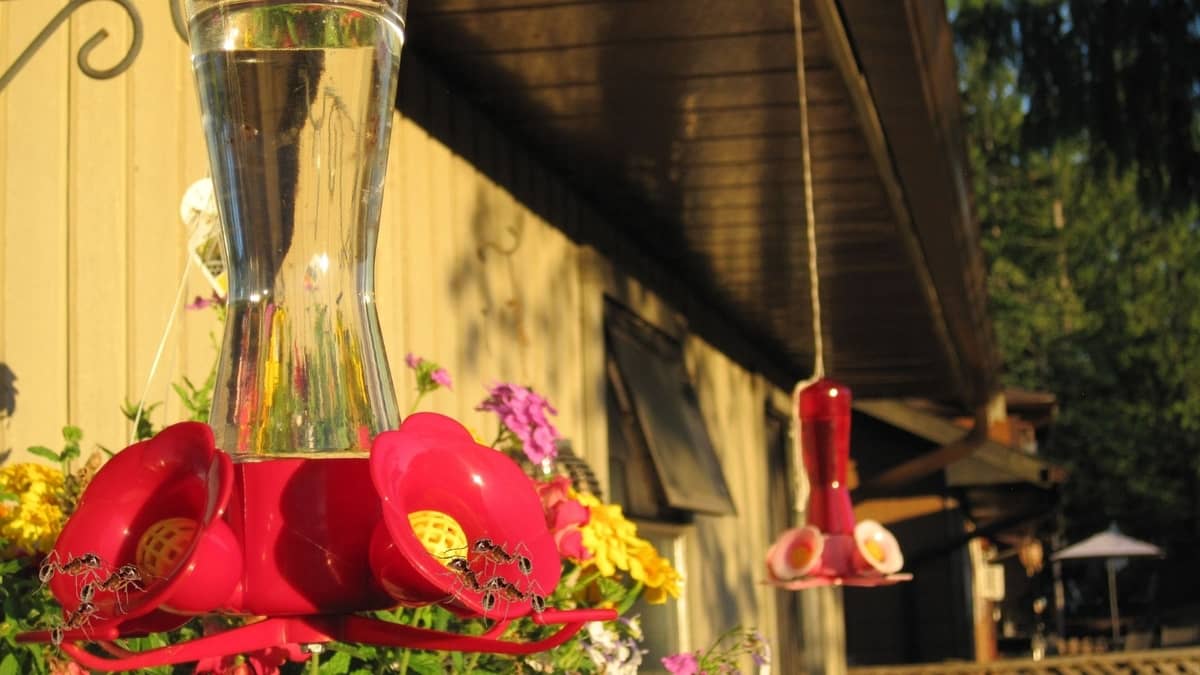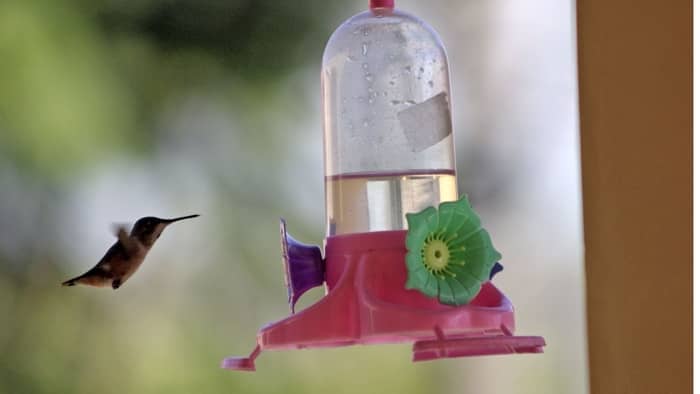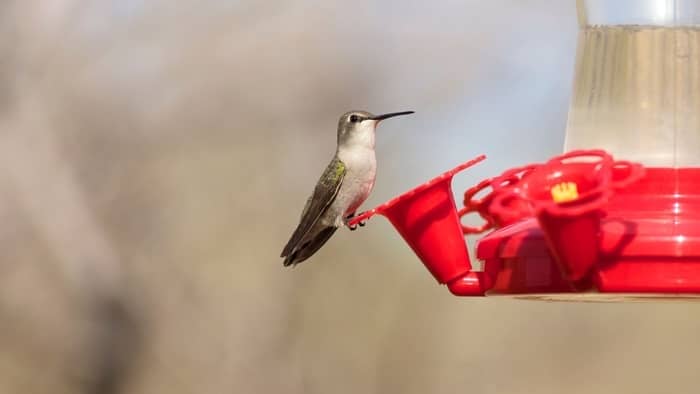Last Updated on February 13, 2022 by Guillermina
When keeping your hummers safe and well-fed is your priority, you have to either build or purchase ant traps for hummingbird feeders. The sweet nectar is equally attractive to hummingbirds but also to insects like ants, flies, and bees. While you try to draw in hummingbirds to your yard, you might end up with an ant infestation. Moreover, ants are not a food of preference to the hummers. The ants often get stuck or drown while eating and clog up the feeder.
If you notice your frequent visitors avoiding a particular feeder, it might be time for some ant traps for hummingbird feeders.
When To Ant Proof Hummingbird Feeder
It’s best to install an ant moat as soon as you put out your hummingbird feeders. Ants never travel alone. They’re very social, live in colonies, travel in groups, and can often be spotted walking in a line to a new food spot. That spot can be your feeder.
But how do they reach the feeder? Ants have up to 5 times more powerful smell receptors than other insects. They can sense the food from afar and find their way to your feeder. They don’t fly, so there’s only one way to access the feeder – through the attachment.
We spoke about how it’s best to position your feeders on a tree in the shade to protect the nectar from spoiling. This is where ants benefit. They climb the tree’s trunk and walk on the branches to your feeder.
There are different ant traps for hummingbird feeders, and as long as they prevent the insects from swarming your feeder, they’re good.
How Do You Make An Ant Trap For A Hummingbird Feeder
Several hummingbird feeders on the market come with preinstalled ant traps. But if your feeder is a smaller size, the trap is shallow and the water that’s supposed to catch the ants dries up quickly. If you love a good DIY or a better solution, you can always make ant traps for hummingbird feeders yourself. Below are our suggestions.
Plastic Bottle DIY
Take an empty 2-liter plastic bottle and clean it thoroughly. Then, use a utility knife to cut the top quarter of the bottle or just follow the mark. Buff the rough edges with sandpaper.
Cut 12 inches of aluminum wire and drill a hole in the bottle cap. Insert 4 inches of the wire through the bottom part of the cap and seal the hole with hot glue. Bend both edges.
Now, unhook and clean your feeder of any ants. Next, hang your ant trap on the same spot, and hook the feeder on the lower section of the trap. Fill up the trap with water, and you’re done.
Petroleum Jelly
Make slippery ant traps for hummingbird feeders with petroleum jelly. This works best if your feeder is hung on a pole. Spread petroleum jelly on the base of the pole and up to the middle. Don’t put it near the feeder as the bird’s wings might brush against it and get damaged. But ants won’t be able to climb to the feeder.
Fishing Line
Branches are poles are easy to climb, but fishing lines are sharp, thin, and slippery. Instead of hanging your feeder directly, use a fishing line to tie it to a branch or pole.
Beware that this works best for sheltered feeders. Don’t hang your feeder with the fishing line it there’s a lot of wind as it can easily hit against something and break.
Do Hummingbirds Eat Ants
Hummingbirds feed on small insects for their daily dose of protein. Up to 80% of their daily intake is made up of mosquitoes, small spiders, beetles, and fruit flies. However, they won’t consume ants trapped in the feeder. If you counted on the hummers to repel the ants from the feeder, it’s not going to happen.
The ant traps for hummingbird feeders are a product of years of experience in monitoring the bird’s behavior. Research shows that hummingbirds will always avoid a food source infested with ants when given a choice. Even when it comes to natural nectar, hummingbirds don’t feed off flowers that have ants inside.
Can Ants Kill Hummingbirds
Ants can infest a feeder and die, contaminating the nectar. The contaminated nectar can be poisonous to hummingbirds, so it’s crucial to check it daily and keep the ants away.
Ants and hummingbirds feed off the same food sources. Since hummingbirds avoid the spots with ants, they can easily starve or move away from your yard. Ants are not a natural predator to the hummingbirds but a significant rival.
Hummingbird Feeder Ant Guard vs Bee Guard
The ant traps for hummingbird feeders and bee guards are completely different things. Although these two insects, including wasps, are closely related, they’re very distinct. They approach the feeder in different ways, so a single guard won’t repel both.
The bee guards are added to the feeding ports and allow just the tiny beak of the hummingbird to access the nectar. But during the summer heat, it’s not unusual to see wasps drowned in the ant moat on top of your feeder.
Final Say: Are Ant Traps For Hummingbird Feeders Necessary?
Ants have an extremely refined sense of smell, so they will locate your feeder sooner rather than later. Installing ant traps for hummingbird feeders on time will prevent nectar contamination and will keep you hummers fed.
Ants are a natural competitor to hummingbirds when it comes to food sources. The hummers are proven to avoid feeders with ant infestations. If you’re handy, you can make ant moats on your own with just a plastic bottle or use our other suggestions.
If you don't want to use water-filled ant moats, you can pick one the Perky Pet ant moat with Permethrin. Our best ant moat is the top of a 2-liter plastic bottle since it fits a lot of water that won't evaporate quickly on hot summer days. It's environment-friendly and cheap to craft at home. Vaseline is pure petroleum jelly, and it will keep ants away from your feeder. But don't spread it near the feeder or in spots where hummingbirds frequently stand. Instead, cover the base of the pole where ants start to climb to your feeder.
What is the best ant moat for hummingbird feeder?
Will Vaseline keep ants off hummingbird feeder?
Meri is a passionate wildlife enthusiast with a special interest in hummingbirds. She loves to observe and learn about the different species of hummingbirds from around the world. After graduating from college with a degree in biology, Meri decided to pursue her dream of writing about hummingbirds and the importance of their conservation. She has since published several articles on the subject in various magazines and online publications. Her articles focus on the importance of habitat preservation, how hummingbirds contribute to ecosystem balance, and the unique behaviors of various species. When she’s not writing, Meri enjoys bird watching and taking pictures of her feathered friends. She also volunteers at her local wildlife center, helping to protect and rehabilitate injured or orphaned hummingbirds. Meri’s passion for hummingbirds drives her to spread awareness and promote their conservation, so that future generations will be able to enjoy their beauty.



